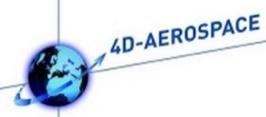PAGE CONTENTS
Objectives
The objective of the activity is to develop and test an end-to-end system simulator that provides performance indicators which are key for the development of UAV satellite terminals. Beyond this, SatCom link feasibility and limitations for certain UAV operations shall be simulated, tested and verified; UAV operations, in particular in Beyond Visual Line of Sight (BVLOS) scenarios, shall be made plannable end-to-end. The System Simulator for UAV Terminal Development (UAV-3S) will support both command and control and payload data communication, GSO and NGSO constellations, a variety of UAVs and realistic terrain morphology.
The main targeted improvement with the target technology readiness level of four is to enable key system tools needed for the design of UAV satellite terminals. More specifically, these system tools aim to identify the UAV satellite terminal gain needed in the whole range of elevation and azimuth to ensure the required link availability and link performance in all flight phases.
Evaluating the expected satellite communication link performance of UAVs in extreme situations e.g. low elevation angles, high pitch and/or roll angles, and blockage due to terrain or buildings is particularly challenging and requires system modelling capabilities not available today. Consequently, this can lead to overdesign or under design of the satellite terminal compromising the communication link.
This activity will advance UAV satellite terminal design by assessing the impact of such extreme flight conditions on the link and deriving accordingly the required terminal performance to ensure link availability and link performance in all flight phases. Thus, the UAV-3S should consider the impact of a large variety of realistic terrain features (multipath, shadowing, blockage, etc.), UAV configurations, flight paths and flight manoeuvres. To achieve this, a system simulator will be developed that takes in particular governmental applications into account. The simulator will be flexible and will allow simulating communication links in frequency bands from L- up to Q/V-band and with GSO satellites but also NGSO constellations. Consequently, the simulator is to be used to derive reference satellite terminal requirements that will be benchmarked against existing terminals.
Testing will be carried out by assessing the performance of UAV command and control and payload data links for a number of manoeuvres and low-altitude flight paths. The link performance will be assessed as a minimum in terms of throughput, availability, latency and reliability (key performance indicators) for different flight phases of UAVs.
Challenges
Some potential challenges related to the project are:
-
Availability and magnitude of input data required to effectively and realistically model UAV systems (e.g., UAV traces, attitude, channel models, ground morphology).
-
Run-time performance of the UAV-3S system simulator such that it could be run also simulations with larger set of UAVs and satellite constellations, but also long enough simulation campaigns.
-
Enabling easy to use graphical user workflow in terms of simulator configuration, input data handling, but also generation of visual demonstrations as an output.
System Architecture
The UAV 3s simulator will consist of 4 main components:
-
Simulator: executes the prepared simulation
- Update of geometry (position and orientation of objects: Satellite and UAV)
- Atmospheric influence
- Visibility checks
- Link performance as result
-
GUI: interaction with user: import, create, edit, modify of data and configuration
-
Database: stores all relevant data, configuration and reports
-
Simulation configuration build tool: converts the configuration in a script which can be run independently of the GUI and database (intended for parallel and distributed computing)
Plan
The project started in November 2023 and with 24 months duration is scheduled to end in October 2025.
The work has been divided into following work packages:
-
WP 1.0: UAV Analysis
-
WP 2.0: Scenarios and System Requirements Definition
-
WP 3.0: Requirements, Architecture, Design, Test Plan and User Manual
-
WP 4.0: Development and Inputs Collection
-
WP 5.0: UAV-3S Simulation Report
-
WP 6.0: Scenario Solutions
-
WP 7.0: Management and Reporting
Current Status
The Project started officially on Nov. 1st 2023 and is currently ongoing.



